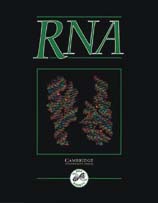Positions in the 30S ribosomal subunit proximal to the 790 loop as determined by phenanthroline cleavage
Published online by Cambridge University Press: 01 July 1999
Abstract
Positioning rRNA within the ribosome remains a challenging problem. Such positioning is critical to understanding ribosome function, as various rRNA regions interact to form suitable binding sites for ligands, such as tRNA and mRNA. We have used phenanthroline, a chemical nuclease, as a proximity probe, to help elucidate the regions of rRNA that are near neighbors of the stem-loop structure centering at nt 790 in the 16S rRNA of the Escherichia coli 30S ribosomal subunit. Using phenanthroline covalently attached to a DNA oligomer complementary to nt 787–795, we found that nt 582–584, 693–694, 787–790, and 795–797 were cleaved robustly and must lie within about 15 Å of the tethered site at the 5′ end of the DNA oligomer, which is adjacent to nt 795 of 16S rRNA.
Information
- Type
- Research Article
- Information
- Copyright
- © 1999 RNA Society
- 4
- Cited by

